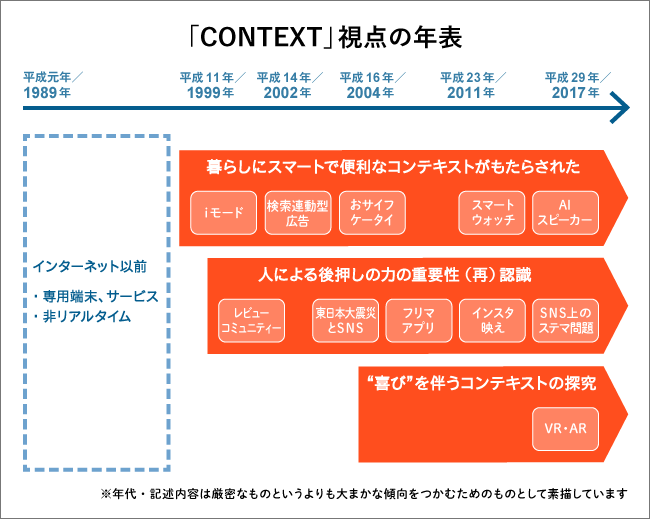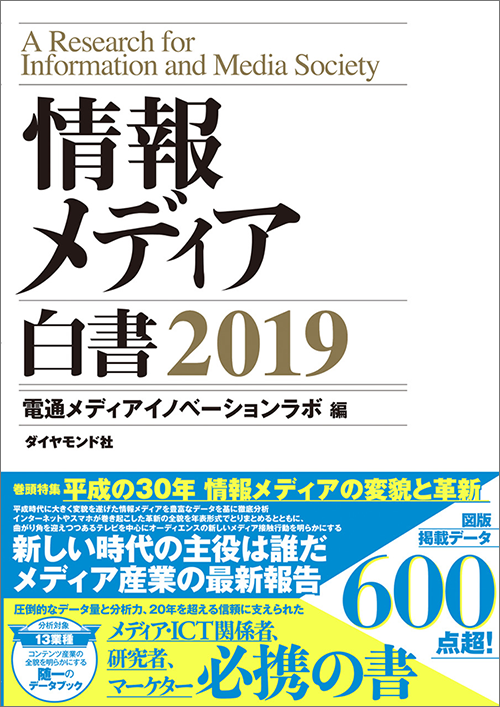Dentsu Inc. Media Innovation Lab published the "Information Media White Paper 2019" (Diamond Inc.) in February.
The opening feature, titled "30 Years of Heisei: The Transformation and Innovation of Information Media," looks back on the evolution of media up to the present, examining both user trends and business developments.
Parts 3 through 5 (this installment) of the series explore the value (wealth) information media has brought to our society over the 30 years of the Heisei era, using three "Cs" – Communication, Content, and Context – as key interpretive lenses.
This fifth installment concludes the series by examining the past 30 years through the lens of the third "C": Context.
【Table of Contents】
▼Expanding the Possibilities of Context is the Role of Information Media
▼Smart and Convenient Context Brought to Daily Life
▼Human-Powered Support Remains Crucial in the Era of Advanced Recommendation Engines
▼Will New Contextual Encounters Emerge Through Experiential Engagement?
The Role of Information Media: Expanding the Possibilities of Context
"Context" is often translated as "文脈" (bunkyaku). While there are various interpretations of what context is, let's consider it here as "the combination and interconnection of the situations surrounding us in everyday life and the things we can think or do within them."
Over the past 30 years, a major role of information media has been to broaden the range of choices and enhance the quality of the combinations of situations and actions surrounding people. Let's immediately look at events excerpted from the timeline in the 'Information Media White Paper 2019', reflect on the richness they brought us, and consider future challenges.

Smart and convenient contexts were introduced into daily life
1998: Google founded
2002: Google AdWords launched in Japan The world is now entering a full-fledged AI era. One of the origins of this shift can be traced back to Google's founding 20 years ago. Beyond its advanced internet search services, Google built the foundation for its status as a major platform operator through "AdWords," a service displaying ads (search-linked ads) relevant to users' search terms.
Both search services and search-linked advertising have continuously evolved as mechanisms to provide appropriate general information and product information tailored to people's personal needs, expanding their usage scenarios. They may be considered prime examples of how information media have played a role in making life contexts smarter and more convenient.
1999: NTT DoCoMo launches i-mode, a mobile phone internet access service. Information services that customize the latest weather, traffic, and transit information based on the desired time and location are now commonplace. However, many of these services only became accessible to the general public through the integration of mobile devices and the internet. The launch of i-mode in 1999 marked a significant step forward in Japan.
Mobile internet has contributed to improving our quality of life by making it easier to adjust our daily schedules and expand our freedom of action.
2001: JR East launches Suica IC card tickets
2004: NTT DoCoMo releases mobile wallet-compatible handsets
2016: Apple Pay launches in Japan Furthermore, the penetration of mobile media into daily life has expanded its scope from "supporting planned actions through information provision" to "supporting actions in the moment."
One representative area is "payment." In 2001, electronic money services like Suica and Edy (now Rakuten Edy) began full-scale operation, and ETC payments for expressway tolls also started full-scale operation that year.
Three years later, Japan pioneered the "Osaifu-Keitai" (Mobile Wallet) service, integrating electronic money functionality into mobile phones. Globally, around 2016, when Apple Pay was introduced on the iPhone, numerous "cashless payment" methods using smartphones emerged for physical stores, ushering in an era of fierce competition.
A notable change in this payment ecosystem was the expansion of the "points economy." Rakuten Super Points (2002) and T Points (2003) emerged, and during the 2000s, mutual exchange services with airline mileage programs also gained attention.
2015: Apple Watch released
2017: Smart speakers like Amazon Echo and Google Home gain popularity
In recent years, the support provided by information media for daily life contexts has become increasingly rich and intelligent. Examples include wearable devices, epitomized by the 2015 release of the Apple Watch, and smart speakers like Amazon Echo and Google Home, which appeared in 2017.
Wearables are gaining traction primarily in the healthcare domain, tracking metrics like heart rate, steps, and sleep. They are winning over users who want to monitor their daily physical condition and enhance their quality of life (QOL) through appropriate exercise and sleep management.
Smart speakers, also known as "AI speakers," analyze user voice commands, accurately infer needs, and interactively perform tasks like controlling home appliances, playing information or content, and assisting with online shopping. Powered by AI (artificial intelligence), an era is approaching where advanced contextual support tailored to each individual's situation is becoming a reality.
The era of advanced recommendation engines makes human support more crucial than ever
The internet truly demonstrated its value as an information medium unlike any previous era when facing large-scale disaster situations.
1995: During the Great Hanshin-Awaji Earthquake, the internet was used for safety confirmations and other purposes.
2011: During the Great East Japan Earthquake, the usefulness of information dissemination via SNS like Twitter and YouTube was reaffirmed. In both major disasters that occurred during the Heisei era (the 1995 Great Hanshin-Awaji Earthquake and the 2011 Great East Japan Earthquake), the internet was utilized according to its penetration rate and technological level at the time. Information exchange took place regarding safety confirmation, disaster status, material support, and the disruption and restoration of transportation networks. For people facing difficult situations and trying to take action, information shared by others via the internet proved to be a significant help. I believe this remains true even now, with technology having advanced significantly.
While AI and information processing technologies have made great strides, we have learned through numerous disasters that it is the broad participation and information exchange of people through media that provides the powerful driving force and breakthrough capability needed to confront severe situations.
2010: Emergence of group-buying coupon sites like Groupon and Ponpare
2014: Popularization of flea market apps like Fril and Mercari, along with instant e-commerce platforms like BASE and STORES.jp, leading to increased user-to-user purchasing activity
2017: Search-linked ads, ads based on internet browsing history (retargeting ads), and advanced recommendation engines began playing a major role even in everyday purchasing decisions, beyond just "Instagrammable" items. Furthermore, the pattern of people choosing their actions based on information and calls to action shared by others—as seen in flea market apps like Mercari and instant e-commerce—has not weakened but rather expanded further.
The term "Instagrammable," a buzzword of 2017, emerged as a trend within communities sharing experiences of shops and products through real photos and videos posted by peers.
It is also worth noting the rise of review community sites such as @cosme (1999-) and Kakaku.com (current service name since 2000), which are driven by user-generated product reviews and word-of-mouth, as a manifestation of the universal power of peer influence.
2012: "Fake" reviews on word-of-mouth sites and "stealth marketing" on social media become social issues. On the other hand, in recent years, as companies have focused on the power of these online communities and engaged in new marketing activities, excessive forms of deception, such as "fake" reviews and "stealth marketing," have become rampant, becoming a social issue.
Encountering new contexts through experiential marketing?
Let's take a look back at the flow so far. From Part 3 to this part, we have traced the role that information media has played over the past 30 years along the three value axes of "communication," "content," and "context."

As we've seen this time, our daily lives have become smarter and more convenient by incorporating various services through information media, especially the internet, thereby expanding "context." We've also gained access to information enabling rational, situation-specific choices and reliable word-of-mouth recommendations (though their misuse sometimes becomes a social problem).
Yet paradoxically, we also sense a counterpoint emerging. In an era when far less information was available than today, encountering that scarce, precious information evoked an intense "joy." The joy of encountering information that made you want to exclaim, "Ah, I get it! This is what I've been searching for all along!" (This is called serendipity). It seems this kind of joy has become harder to feel, perhaps as a trade-off for gaining the context of a smart and convenient life.
Moreover, precisely because of this, we can say that next-generation systems capable of providing encounters with strikingly fresh new contexts are eagerly awaited.
Moving forward, opportunities for encountering new contexts accompanied by strong joy may shift their emphasis from the traditional form of encountering "information" to the form of experiencing it firsthand. In recent years, participation in music festivals and real-world events has surged, particularly among younger generations.
Furthermore, the rapidly evolving VR (Virtual Reality) technology also holds significant potential. VR is highly promising as an approach that brings the value of joy to the intersection of novel forms of "information" expression and "experience."
Events and VR are examples of potential future directions, but considering the changes over the past 30 years, it will surely not stop there. At Dentsu Inc. Media Innovation Lab, we intend to continue our research, imagining a future where the still-unforeseeable evolution of information media in the Reiwa era brings new joy to the context of people's lives.
The full version of the timeline, which could not be included in this article due to space constraints, is reproduced in the 'Information Media White Paper 2019'. We would be delighted if you could obtain a copy and review it.







